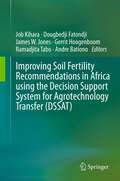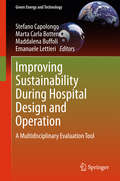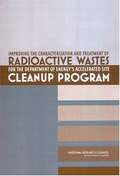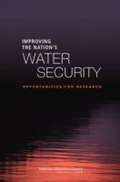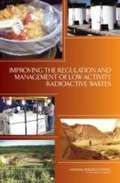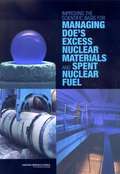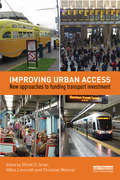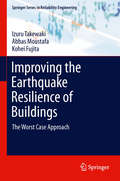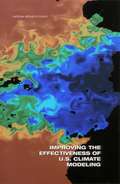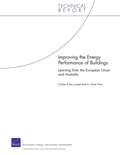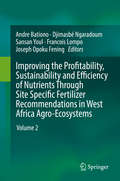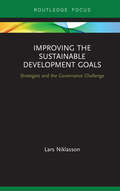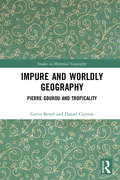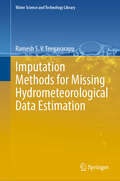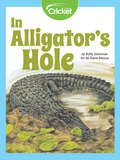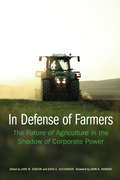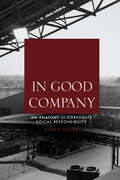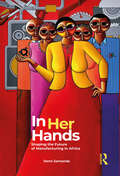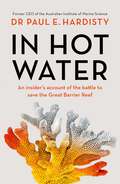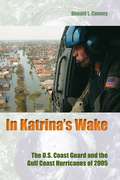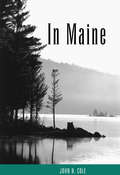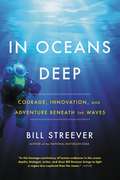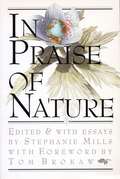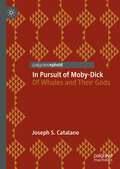- Table View
- List View
Improving Soil Fertility Recommendations in Africa using the Decision Support System for Agrotechnology Transfer (DSSAT)
by Andre Bationo Job Kihara Gerrit Hoogenboom Ramadjita Tabo Dougbedji Fatondji James W JonesThe book gives a detailed description of the application of DSSAT in simulating crop and soil processes within various Agro-ecological zones in Africa. The book, an output of a series of 3 workshops, provides examples of the application of DSSAT models to simulate nitrogen applications, soil and water conservation practices including effects of zai technology, phosphorus and maize productivity, generation of genetic coefficients, long-term soil fertility management technologies in the drylands, microdosing, optimization of nitrogen x germplasms x water, spatial analysis of water and nutrient use efficiencies and, tradeoff analysis. The minimum dataset requirements for DSSAT is discussed. This book arises from attempts to address the limited use of models in decision support by African agricultural (both soil scientist and agronomists) scientists.
Improving Sustainability During Hospital Design and Operation
by Stefano Capolongo Marta Carla Bottero Maddalena Buffoli Emanuele LettieriThis book describes the Sustainable High Quality Healthcare (SustHealth) project, which had the goal of developing an original multidisciplinary evaluation tool that can be applied to assess and improve hospitals' overall sustainability. The comprehensive nature of the appraisal offered by this tool exceeds the scope of most current rating systems, which typically permit a thorough evaluation of relevant environmental factors when designing a new building but fail to consider social and economic impacts of the design phase or the performance of the hospital's operational structure in these fields. The multidisciplinary evaluation system was developed, from its very inception through to its testing, by following a scientific experimental method in which a global perspective was constantly maintained, as opposed to a focus only on specific technical issues. Application of the SustHealth rating tool to a currently functioning hospital, or one under design, will identify weaknesses and guide users to potential low-cost short-term solutions and longer-term strategies for improvement.
Improving The Characterization And Treatment Of Radioactive Wastes For The Department Of Energy's Accelerated Site Cleanup Program
by National Research Council of the National AcademiesThe Department of Energy’s Office of Environmental Management (EM) directs the massive cleanup of more than 100 sites that were involved in the production of nuclear weapons materials during the Manhattan Project and the Cold War. This report offers suggestions for more effectively characterizing and treating the orphan and special-case wastes that are part of EM’s accelerated cleanup program. It identifies technical opportunities for EM to improve the program that will save time and money without compromising health and safety. The opportunities identified include: making more effective use of existing facilities and capabilities for waste characterization, treatment, or disposal; eliminating self-imposed requirements that have no clear technical or safety basis; and investing in new technologies to improve existing treatment and characterization capabilities. For example, the report suggests that EM work with DOE classification officers to declassify, to the extent possible, classified materials declared as wastes. The report also suggests a new approach for treating the wastes that EM will leave in place after cleanup.
Improving The Nation's Water Security: Opportunities For Research
by National Research Council of the National AcademiesConcern over terrorist attacks since 2001 has directed attention to potential vulnerabilities of the nation’s water and wastewater systems. The Environmental Protection Agency (EPA), which leads federal efforts to protect the water sector, initiated a research program in 2002 to address immediate research and technical support needs. This report, conducted at EPA’s request, evaluates research progress and provides a long-term vision for EPA’s research program. The report recommends that EPA develop a strategic research plan, address gaps in expertise among EPA program managers and researchers, and improve its approaches to information dissemination. The report recommends several high-priority research topics for EPA, including conducting empirical research in behavioral science to better understand how to prepare people for water security incidents.
Improving The Regulation And Management Of Low-activity Radioactive Wastes
by National Research Council of the National AcademiesThe largest volumes of radioactive wastes in the United States contain only small amounts of radioactive material. These low-activity radioactive wastes (LAW) should be regulated and managed according to the degree of risk they pose for treatment, storage, and disposal. Current regulations are based primarily on the type of industry that produced the waste-the waste's origin-rather than its risk. In this report a risk-informed approach for regulating and managing all types of LAW in the United States is proposed. Implemented in a gradual or stepwise fashion, this approach combines scientific risk assessment with public values and perceptions. It focuses on the hazardous properties of the waste in question and how they compare with other waste materials. The approach is based on established principles for risk-informed decision making, current risk-informed initiatives by waste regulators in the United States and abroad, solutions available under current regulatory authorities, and remedies through new legislation when necessary.
Improving The Scientific Basis For Managing Doe's Excess Nuclear Materials And Spent Nuclear Fuel
by Committee on Improving the Scientific Basis for Managing Nuclear Materials Spent Nuclear Fuel through the Environmental Management Science ProgramThis study identifies research opportunities for storage, recycle, reuse, or disposal of nuclear materials and spent nuclear fuel. Most of the materials dealt with in this report have not been declared as waste. The report completes the fifth in a series of studies requested by the EMSP to assist in developing its calls for proposals and evaluating proposals on this issue. There is no subject index. Annotation ©2004 Book News, Inc. , Portland, OR (booknews. com)
Improving Urban Access: New Approaches to Funding Transport Investment
by Christian Wolmar Elliott D. Sclar Måns LönnrothBy 2050, two-thirds of the world’s population will live in cities. To thrive, they will need efficient and sustainable forms of transport, but to achieve this, the financial incentives guiding urban transport operation must change – and change rapidly. Urban transport plays a critical role in determining the social, environmental and economic shape of cities. Improving Urban Access: New Approaches to Funding Transport Investment provide innovative ideas on how we might reorganize transport finance to ensure that it is suited to serving the social, environmental and economic principles that must guide future urban living. Continuing the work begun by its predecessor, Urban Access for the 21st Century, the authors assess the complexity of implementing new finance approaches and suggest ways to make positive and radical changes. Although the range of revenue raising options remain limited to users, indirect beneficiaries, and the general public, these can be recast to transform the way transport is paid for and therefore how its services are delivered. New finance models only succeed when they are intrinsically linked to the economic, social, cultural and political forces that create urban life. Together these volumes provide a starting point for the deeper research and policy design needed to successfully create urban transport finance systems that can address the challenges that 21st century cities present.
Improving the Earthquake Resilience of Buildings
by Izuru Takewaki Kohei Fujita Abbas MoustafaEngineers are always interested in the worst-case scenario. One of the most important and challenging missions of structural engineers may be to narrow the range of unexpected incidents in building structural design. Redundancy, robustness and resilience play an important role in such circumstances. Improving the Earthquake Resilience of Buildings: The worst case approach discusses the importance of worst-scenario approach for improved earthquake resilience of buildings and nuclear reactor facilities. Improving the Earthquake Resilience of Buildings: The worst case approach consists of two parts. The first part deals with the characterization and modeling of worst or critical ground motions on inelastic structures and the related worst-case scenario in the structural design of ordinary simple building structures. The second part of the book focuses on investigating the worst-case scenario for passively controlled and base-isolated buildings. This allows for detailed consideration of a range of topics including: A consideration of damage of building structures in the critical excitation method for improved building-earthquake resilience, A consideration of uncertainties of structural parameters in structural control and base-isolation for improved building-earthquake resilience, and New insights in structural design of super high-rise buildings under long-period ground motions. Improving the Earthquake Resilience of Buildings: The worst case approach is a valuable resource for researchers and engineers interested in learning and applying the worst-case scenario approach in the seismic-resistant design for more resilient structures.
Improving the Effectiveness of U.S. Climate Modeling
by Panel on Improving the Effectiveness of U.S. Climate ModelingThis study addresses challenges posed in the Climate Research Committee's 1998 report, Capacity of US Climate Modeling to Support Climate Change Assessment Activities. It examines major types of climate modeling, describes the computational and human resources required to conduct climate modeling, quantitatively assesses the computational and human resources that are presently directed toward climate modeling, and describes ways in which the US climate modeling enterprise might be improved. The study contains no subject index. Annotation c. Book News, Inc. , Portland, OR (booknews. com)
Improving the Energy Performance of Buildings
by Charles P. Ries Oliver Wise Joseph JenkinsThis study examines how policies to increase energy efficiency in buildings in the European Union and Australia have worked and draws implications for the design of similar public policies for the United States. It appears that effective policies to promote energy efficiency can be devised using information disclosure, building codes, financial incentives, and benchmarking. Insights are presented to help designers of analogous U.S. policies.
Improving the Profitability, Sustainability and Efficiency of Nutrients Through Site Specific Fertilizer Recommendations in West Africa Agro-Ecosystems
by Andre Bationo Djimasbé Ngaradoum Sansan Youl Francois Lompo Joseph Opoku FeningAs part of its efforts to improve fertilizer use and efficiency in West Africa, and following the recent adoption of the West African fertilizer recommendation action plan (RAP) by ECOWAS, this volume focuses on IFDC's technical lead with key partner institutions and experts to build on previous and current fertilizer recommendations for various crops and countries in West Africa for wider uptake by public policy makers and fertilizer industry actors.
Improving the Profitability, Sustainability and Efficiency of Nutrients Through Site Specific Fertilizer Recommendations in West Africa Agro-Ecosystems
by Andre Bationo Djimasbé Ngaradoum Sansan Youl Francois Lompo Joseph Opoku FeningAs part of its efforts to improve fertilizer use and efficiency in West Africa, and following the recent adoption of the West African fertilizer recommendation action plan (RAP) by ECOWAS, this volume focuses on IFDC's technical lead with key partner institutions and experts to build on previous and current fertilizer recommendations for various crops and countries in West Africa for wider uptake by public policy makers and fertilizer industry actors.
Improving the Sustainable Development Goals: Strategies and the Governance Challenge (Routledge Focus on Environment and Sustainability)
by Lars NiklassonImproving the Sustainable Development Goals evaluates the Global Goals (Agenda 2030) by looking at their design and how they relate to theories of economic development. Adopted unanimously by the member states of the United Nations (UN) in 2015, the goals are remarkable for the global commitment on a set of targets to reach by 2030, but also for the lack of a strategy of implementation. The choice of appropriate action is handed over to individual governments, some of which are limited by their lack of resources. This book explores how implementation of the sustainable development goals (SDGs) can be developed, especially in developing countries. The content, strengths and weaknesses of the SDGs are critically examined, alongside their relationship to ongoing academic research. The authors also investigate the actions of governments over the past three years by looking at the national strategies they have presented at annual meetings of the UN High-Level Political Forum. Improving the Sustainable Development Goals takes a critical but constructive approach, pointing out risks as well as possible remedies. The SDGs are seen as an opportunity for a global conversation on what works in solving some fundamental problems relating to poverty and environmental degradation. With the inclusion of a chapter by Tobias Ogweno, former member of the Kenya’s UN mission, this book will appeal to all those who are interested in policy analysis with a focus on development issues.
Impure and Worldly Geography: Pierre Gourou and Tropicality (Studies in Historical Geography)
by Gavin Bowd Daniel ClaytonTropicality is a centuries-old Western discourse that treats otherness and the exotic in binary – ‘us’ and ‘them’ – terms. It has long been implicated in empire and its anxieties over difference. However, little attention has been paid to its twentieth-century genealogy. This book explores this neglected history through the work of Pierre Gourou, one of the century’s foremost purveyors of what anti-colonial writer Aimé Césaire dubbed tropicalité. It explores how Gourou’s interpretations of ‘the nature’ of the tropical world, and its innate difference from the temperate world, were built on the shifting sands of twentieth-century history – empire and freedom, modernity and disenchantment, war and revolution, culture and civilisation, and race and development. The book addresses key questions about the location and power of knowledge by focusing on Gourou’s cultivation of the tropics as a romanticised, networked and affective domain. The book probes what Césaire described as Gourou’s ‘impure and worldly geography’ as a way of opening up interdisciplinary questions of geography, ontology, epistemology, experience and materiality. This book will be of great interest to scholars and students within historical geography, history, postcolonial studies, cultural studies and international relations.
Imputation Methods for Missing Hydrometeorological Data Estimation (Water Science and Technology Library #108)
by Ramesh S.V. TeegavarapuMissing data is a ubiquitous problem that plagues many hydrometeorological datasets. Objective and robust spatial and temporal imputation methods are needed to estimate missing data and create error-free, gap-free, and chronologically continuous data. This book is a comprehensive guide and reference for basic and advanced interpolation and data-driven methods for imputing missing hydrometeorological data. The book provides detailed insights into different imputation methods, such as spatial and temporal interpolation, universal function approximation, and data mining-assisted imputation methods. It also introduces innovative spatial deterministic and stochastic methods focusing on the objective selection of control points and optimal spatial interpolation. The book also extensively covers emerging machine learning techniques that can be used in spatial and temporal interpolation schemes and error and performance measures for assessing interpolation methods and validating imputed data. The book demonstrates practical applications of these methods to real-world hydrometeorological data. It will cater to the needs of a broad spectrum of audiences, from graduate students and researchers in climatology and hydrological and earth sciences to water engineering professionals from governmental agencies and private entities involved in the processing and use of hydrometeorological and climatological data.
In Alligator's Hole
by Buffy Silverman Diane BlasiusDuring the rainy season in the marshlands, Alligator has almost nothing to eat. When the dry season comes, Alligator digs a hole in the pond and waits for the animals to return. Without Alligator and her hole, there would be far fewer animals living in the marsh.
In Defense of Farmers: The Future of Agriculture in the Shadow of Corporate Power (Our Sustainable Future)
by Sara Alexander Jane Gibson John K. HansenIndustrial agriculture is generally characterized as either the salvation of a growing, hungry, global population or as socially and environmentally irresponsible. Despite elements of truth in this polarization, it fails to focus on the particular vulnerabilities and potentials of industrial agriculture. Both representations obscure individual farmers, their families, their communities, and the risks they face from unpredictable local, national, and global conditions: fluctuating and often volatile production costs and crop prices; extreme weather exacerbated by climate change; complicated and changing farm policies; new production technologies and practices; water availability; inflation and debt; and rural community decline. Yet the future of industrial agriculture depends fundamentally on farmers’ decisions.In Defense of Farmers illuminates anew the critical role that farmers play in the future of agriculture and examines the social, economic, and environmental vulnerabilities of industrial agriculture, as well as its adaptations and evolution. Contextualizing the conversations about agriculture and rural societies within the disciplines of sociology, geography, economics, and anthropology, this volume addresses specific challenges farmers face in four countries: Bolivia, Brazil, Canada, and the United States. By concentrating on countries with the most sophisticated production technologies capable of producing the largest quantities of grains, soybeans, and animal proteins in the world, this volume focuses attention on the farmers whose labors, decision-making, and risk-taking throw into relief the implications and limitations of our global industrial food system. The case studies here acknowledge the agency of farmers and offer ways forward in the direction of sustainable agriculture.
In Good Company
by Dinah RajakUnder the banner of corporate social responsibility (CSR), corporations have become increasingly important players in international development. These days, CSR's union of economics and ethics is virtually unquestioned as an antidote to harsh neoliberal reforms and the delinquency of the state, but nothing is straightforward about this apparently win-win formula. Chronicling transnational mining corporation Anglo American's pursuit of CSR,In Good Companyexplores what lies behind the movement's marriage of moral imperative and market discipline. From the company's global headquarters to its mineshafts in South Africa, Rajak reveals how CSR enables the corporation to accumulate and exercise power. Interested in CSR's vision of social improvement, Rajak highlights the dependency that the practice generates. This close examination of Africa's largest private sector employer not only brings critical attention to the dangers of corporate dominance, but also provides a lens through which to reflect on the wider global CSR movement.
In Her Hands: Shaping the Future of Manufacturing in Africa: A Woman’s Story
by Demi SamandeAfrica is seen as the next large growth economy, but with this potential comes concerns about exploitation from outside interests. Based on the real-world experiences of Demi Samande, award-winning entrepreneur, this book provides a toolkit for aspirational and savvy African entrepreneurs, as well as insights for responsible investors to seize the opportunity and to help transform the African economy for the benefit of Africa. As a practical guide, the book will inspire a new generation of entrepreneurs to tackle the challenges of doing business and the steps to creating sustainable, successful companies, both large and small. It features interviews with entrepreneurs who are already having success, as well as business executives, artists and creatives who are inspiring the transformation of African business from within and from overseas. Demi’s own story, which she draws upon to illustrate how to build a successful business from scratch, starts in a London flat and traces the development of her company in Nigeria to becoming the premier manufacturer of luxury furniture in West Africa. It also tells her story from the perspective of a female entrepreneur. The book provides a hands-on roadmap for building and sustaining a business of any size and can be used on its own or in conjunction with training, either for entrepreneurs who are already in the process of building a business or for budding entrepreneurs in the classroom.
In Hot Water: Inside the battle to save the Great Barrier Reef
by Paul E. HardistyIn the ongoing climate wars, the Great Barrier Reef has become a symbol of everything that we have to lose from global warming. For years, reports of the world-famous coral being irreversibly bleached have fuelled an ideological battle between those fighting to stop the damage and those who insist the danger is overblown.Paul Hardisty found himself in the middle of this fight during his six years as CEO of the Australian Institute of Marine Science. In this fascinating, candid and urgent book, he dives into the history of the reef and cuts through the rhetoric to chart the circumstances and acceleration of its decline, as well as the determined efforts to save it.In Hot Water is a crucial look inside the battle to save one of Australia's greatest treasures, describing what must be done to preserve it, and what is at risk if we fail to do so.
In Katrina's Wake: The U.S. Coast Guard and the Gulf Coast Hurricanes of 2005 (New Perspectives on Maritime History and Nautical Archaeology)
by Donald L CanneyOf all the Homeland Security agencies operating in New Orleans before, during, and after Hurricane Katrina’s landfall, no agency performed its duties with the same level of diligence and heroism as did the U.S. Coast Guard. Tirelessly, Coasties in helicopters and small boats pulled survivors from rooftops, floating debris, and high ground and ferried them to safety as the rest of us watched live on CNN.Only a few days later, disaster struck again in the form of Hurricane Rita, which left even more people in desperate need of rescue and assistance. In the aftermath of the storms, some 5,000 Coast Guard personnel rescued 33,735 individuals--six times more than the annual average number rescued by the service nationwide. Then, unobserved by the media, the Coast Guard successfully restored the vital navigation aids in the region, preventing further death and destruction.In Katrina’s Wake presents a riveting account of the astounding operations undertaken by the men and women of the U.S. Coast Guard in the aftermath of one of the worst natural disasters ever to strike America. While other government agencies struggled to mobilize and failed to provide real solutions, one small, decentralized agency stepped forward and performed above and beyond the call of duty.
In Maine: Essays On Life's Seasons
by John N. ColeCollection of essays by the late John N. Cole. Cole writes with passion about his life, the outdoors and the glorious rhythms of nature. Originally released in the 1970s and unavailable for two decades, this revised Islandport Press edition features new essays and photographs. For decades, John Cole wrote with passion about his life, the outdoors and the glorious rhythms of nature. In Maine, like all his essays and books, draws deep from his lifelong partnership and his fascination with the natural world from commercial fishing in the waters off Long Island, New York to chasing stripers in Casco Bay, Maine, to quietly observing the shifting winds that roll across the local meadow and the annual change of seasons, a ritual he finds exhilarating. "Few realities life can muster are capable of destroying the zest and richness of September and October in this northeast," he writes. Cole has gained insight and contemplated potential lessons during his journey. He notes the changes that have come to the world and those that are coming. And he laments the basics of nature that too often pass unnoticed today, but remain important parts of our past and possibly our future. "Men cannot live without knowing... knowing which way the wind blows, which way the rain falls, how the sea surges, the land lives and the forest dies." To do so, he says, is unnatural.In Maine, originally published in 1974 and available again for the first time in 25 years, features essays that appeared in the Maine Times during its formative years but remain as fresh and insightful as ever. The revised edition also includes new essays that sparkle with the same energy and enthusiasm as Cole's earlier work.
In Oceans Deep: Courage, Innovation, and Adventure Beneath the Waves
by Bill StreeverIn the spirit of Bill Bryson and Ian Frazier comes this fascinating examination of our past, present, and future beneath the waves.In an age of unprecedented exploration and innovation, our oceans remain largely unknown, and endlessly fascinating: full of mystery, danger, beauty, and inspiration. Bill Streever-a longtime deep-sea diver himself-has masterfully woven together the science and history of Earth's last remaining frontier: the sea. In Oceans Deep celebrates the daring pioneers who tested the limits of what the human body can endure under water: . free divers able to reach 300 feet on a single breath; engineers and scientists who uncovered the secrets of decompression; teenagers who built their own diving gear from discarded boilers and garden hoses in the 1930s; saturation divers who lived under water for weeks at a time in the 1960s; and the trailblazing men who voluntarily breathed experimental gases at pressures sufficient to trigger insanity.Tracing both the little-known history and exciting future of how we travel and study the depths, Streever's captivating journey includes seventeenth-century leather-hulled submarines, their nuclear-powered descendants, a workshop where luxury submersibles are built for billionaire clients, and robots capable of roving unsupervised between continents, revolutionizing access to the ocean. In this far-flung trip to the wild, night-dark place of shipwrecks, trapped submariners, oil wells, innovative technologies, and people willing to risk their lives while challenging the deep, we discover all the adventures our seas have to offer-and why they are in such dire need of conservation.
In Praise of Nature
by Tom Brokaw Stephanie Mills Jeanne CarstensenFive thought-provoking essays by Stephanie Mills are followed by reviews and excerpts of the ten most important pieces of related literature written by experts in the various fields. Reviewers include Peter Borrelli, David Brower, Ernest Callenbach, J. Baird Callicott, Lois Gibbs, and others. Following the essays is an annotated bibliography listing over 100 important environmental works.
In Pursuit of Moby-Dick: Of Whales and Their Gods
by Joseph S. CatalanoThis study presents Moby-Dick as a novel with three distinct but interconnecting stories: Ishmael’s, which he shares ten years after it has taken place; Ahab’s, which is Ishmael's account of the memorable captain of a whaling ship; and a third which centres on whales and whaling, which has not received significant critical attention. While each of these perspectives compete for prominence in the narrative, Ahab and Ishmael's stories have often distracted from the vital significance of the whaling narrative as what outlasts Ahab’s obsessive mission. Catalano rights this wrong by coming to a strikingly original and thought-provoking conclusion which becomes the heart of the book's argument: “the unity of Melville’s book comes, first, from the way the numerous literary, philosophical, and religious reflections are rooted in those magnificent beings, whales and in the men and ships that pursue them, and, second, in the way these reflections illuminate our own lives.”
